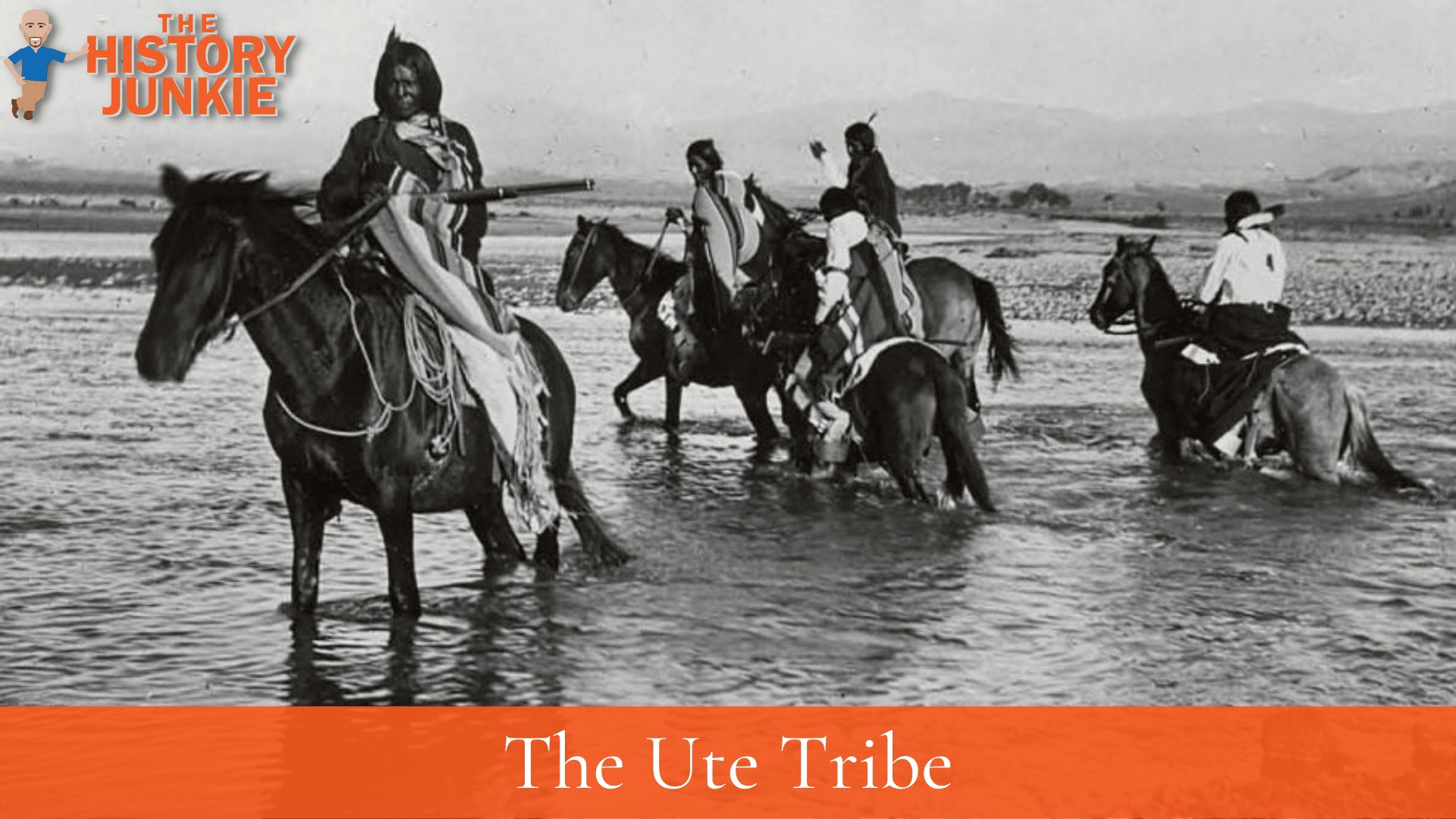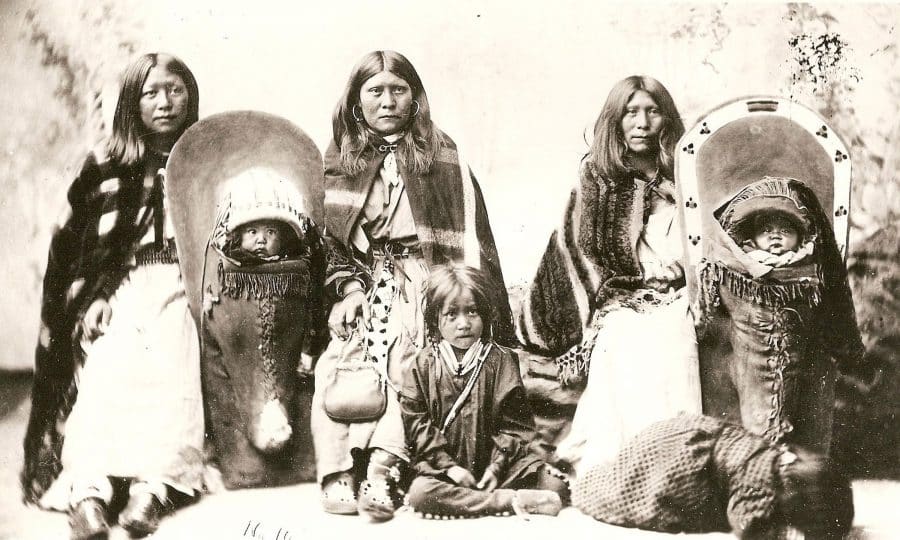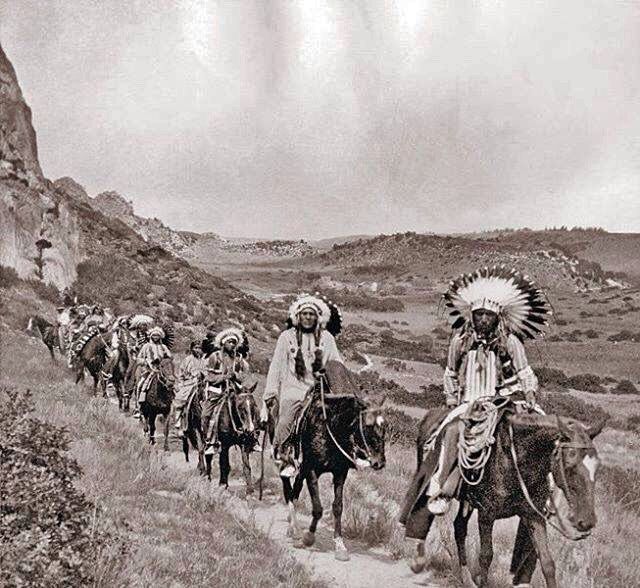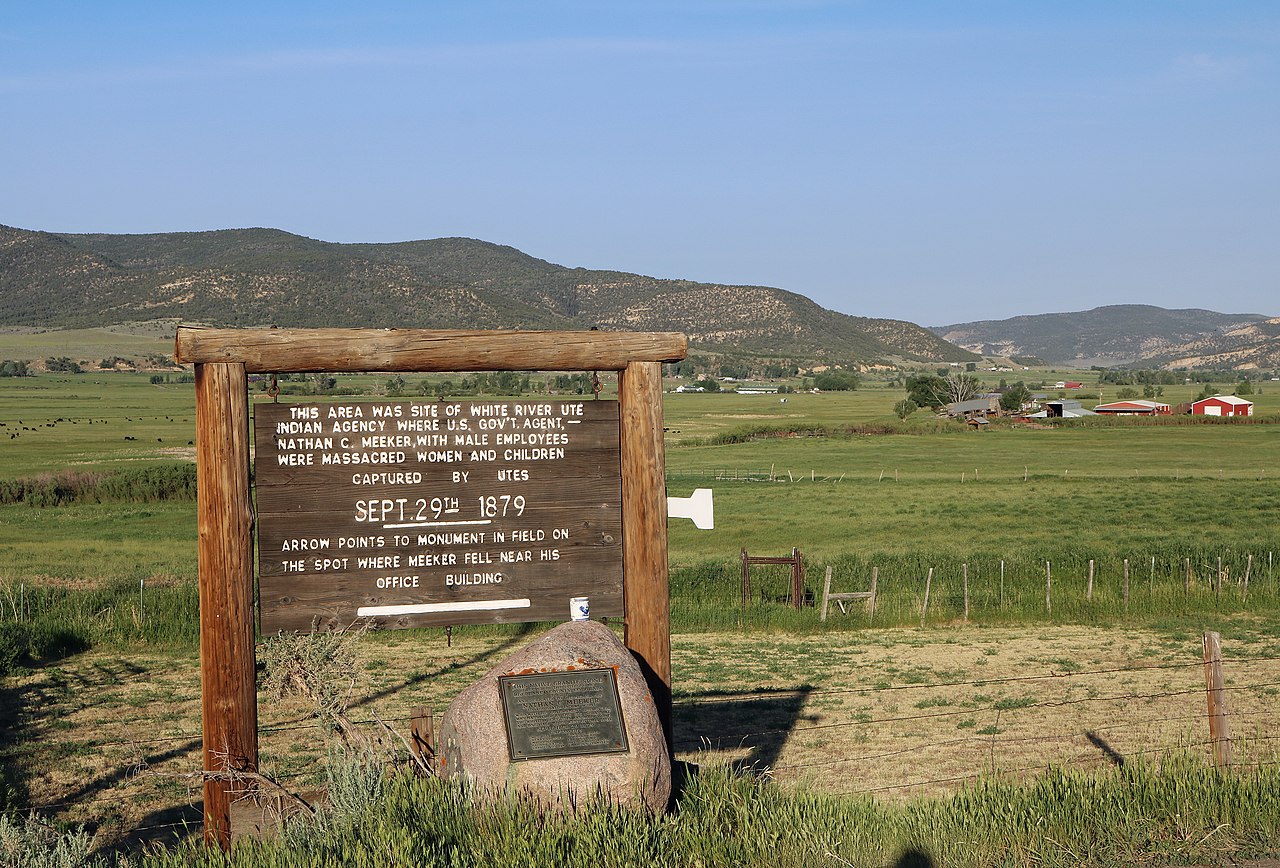The Ute Tribe is a Native American Tribe of the Great Basin. They once lived and thrived in modern-day Utah and Colorado. The state of Utah is named after the tribe, and the University of Utah's mascot is the Utes as well.

In addition to their ancestral lands within Colorado and Utah, their historic hunting grounds extended into current-day Wyoming, Oklahoma, Arizona, and New Mexico. The tribe also had sacred grounds outside their home domain that were visited seasonally.
There were 12 historic bands of Utes. Although they generally operated in family groups for hunting and gathering, the communities came together for ceremonies and trading. Many Ute bands were culturally influenced by neighboring Native American tribes and Puebloans, whom they traded with regularly.
Jump to:
Overview
The Ute Tribe is more than just one tribe. As stated before, there were 12 bands of Utes that lived in various locations, and while they shared many similarities, it is important to look into each of those tribes to understand their own unique history.
The following are the 12 bands and where they used to live:
- Pahvant - Lived in modern-day Utah
- Moanunt - Lived in modern-day Utah
- Sanpits - Lived in modern-day Utah
- Timpanogots - Lived in modern-day Utah
- Uintah - Lived in modern-day Utah
- Seuvarits - Lived in modern-day Utah
- Yampa - Lived in modern-day Colorado
- Pananuche and Sabuagana - Lived in modern-day Colorado and Utah along the Colorado River
- Tabeguache - Lived in modern-day Colorado
- Weeminuche - Lived in modern-day Colorado and Utah
- Capote - Lived in modern-day Colorado
- Muache - Lived in modern-day Colorado
Language
Ute people are from the Southern subdivision of the Numic-speaking branch of the Uto-Aztecan language family, which is found almost entirely in the Western United States and Mexico.
The name of the language family was created to show that it includes both the Colorado River Numic language (Uto) dialect chain that stretches from southeastern California along the Colorado River to Colorado and the Nahuan languages (Aztecan) of Mexico.
Land
There were ancestral Utes in southwestern Colorado and southeastern Utah by 1300, living a hunter-gatherer lifestyle.
The Ute tribe occupied much of the present state of Colorado by the 1600s. the Comanches from the north joined them in eastern Colorado in the early 1700s. In the 19th century, the Arapaho and Cheyenne moved southward into eastern Colorado.
The Utes came to inhabit a large area including most of Utah, western and central Colorado, and south into the San Juan River watershed of New Mexico. Some Ute bands stayed near their home domains, while others ranged further away seasonally.
Hunting grounds extended further into Utah and Colorado, as well as into Wyoming, Oklahoma, Texas, and New Mexico. Winter camps were established along rivers.
Colorado
Many different Ute tribe bands lived in modern-day Colorado. The land in Colorado was not just home to many in the tribe, but much land was considered sacred.
The Tabeguache Ute was called Pike's Peak Tavakiev thousands of years before the first Europeans arrived. Tavakiev was a place where Utes would spend summers hunting and gathering food to eat and store for the winter. The land gave them food, shelter, clothes, and many other resources that they could use, and because of this, Pikes Peak was a sacred ceremonial area for the band.
The mineral springs at Manitou Springs were also sacred, and Ute and other tribes came to the area, spent winters there, and shared in the gifts of the waters without worry of conflict.
Artifacts found from the nearby Garden of the Gods, such as grinding stones, suggest the groups would gather together after their hunt to complete the tanning of hides and processing of meat.
The old Ute Pass Trail went eastward from Monument Creek to Garden of the Gods and Manitou Springs to the Rocky Mountains. From Ute Pass, Utes journeyed eastward to hunt buffalo.
They spent winters in mountain valleys where they were protected from the weather. The North and Middle Parks of present-day Colorado were among the favored hunting grounds due to the abundance of game.
Utah
The Ute appeared to have hunted and camped in an ancient Anasazi and Fremont people campsite near what is now Arches National Park.
At a site near natural springs, which may have held spiritual significance, the Ute left petroglyphs in rock along with rock art by the earlier peoples.
Some of the images are estimated to be more than 900 years old. The Utes petroglyphs were made after the Utes acquired horses because they show men hunting while on horseback
Family and Society
People lived in extended family groups of about 20 to 100 people. They traveled to seasonally-specific camps. In the spring and summer, family groups hunted and gathered food.
The men hunted buffalo, antelope, elk, deer, bear, rabbit, sage hens, and beaver using arrows, spears, and nets. They smoked and sun-dried the meat and also ate it fresh. They also fished in freshwater sources, like Utah Lake.

Women processed and stored the meat and gathered greens, berries, roots, yampa, pine nuts, yucca, and seeds. The Pahvant were the only Utes to cultivate food.
Some western groups ate reptiles and lizards.
Some southeastern groups planted corn, and some encouraged the growth of wild tobacco.
Implements were made of wood, stone, and bone. Skin bags and baskets were used to carry goods. There is evidence that pottery was made by the Utes as early as the 16th century.
Men and women wore woven and leather clothing and rabbit skin robes. They wore their hair long or in braids. Parents provided some input, but people decided who they would take as spouses.
Men could have multiple wives, and divorce was common and easy. There were restrictions for menstruating women and couples who were pregnant. Children were encouraged to be industrious through several rituals.
When someone died, that person was buried in their best clothes with their head facing east. Their possessions were generally destroyed, and their horses either had their hair cut or they were killed.
Occasionally, members of Ute bands met up to trade, intermarry, and practice ceremonies, like the annual spring Bear Dance.
European Contact
The Ute Tribe came into contact with Spanish Conquistadors between 1581 - 1620. The precise date is unknown. However, it occurred due to the high quality of deerskin that was produced by the Utes, and their reputation spread to the Spanish.
They traded with the Spanish in the San Luis Valley beginning in the 1670s, in northern New Mexico beginning in the early 1700s, and in Ute villages in what is now western Colorado and eastern Utah.
The Utes, the main trading partners of the Spanish residents of New Mexico, were known for their soft, high-quality, tanned deer skins, or chamois, and they also traded meat, buffalo robes, and Indian and Spanish captives taken by the Comanche.
The Utes traded their goods for cloth, blankets, guns, horses, maize, flour, and ornaments. A number of Utes learned Spanish through trading.
The Spanish seriously guarded trade with the Utes, limiting it to annual caravans, but by 1750, they were reliant on the trade with the Utes, their deerskin being a highly sought commodity.
The Utes also traded in slaves, women, and children captives from Apache, Comanche, Paiute, and Navajo tribes. (Although rarely spoken of, many Native Americans practiced slavery)
In 1637, the Spanish fought with the Utes, 80 of whom were captured and enslaved. Three people escaped with horses.
The acquisition of the horse and its implementation into Ute tribe life would change their lifestyle. It made the tribe more mobile, and their culture shifted to look more like a Great Plains Indian culture rather than a Great Basin tribe.
They were able to trade more often and effectively hunt larger games. Soon, the Ute tribe would be known for the prowess of the horse. They became skilled warriors and fantastic at horse racing.
During this time, few people entered Ute territory. Exceptions to this include the Dominguez–Escalante expedition of 1776 and French trappers passing through the area or establishing trading posts beginning in the 1810s.
The French expedition recorded meeting members of the Moanunts and Pahvant bands
Rise of the Warriors
After the Utes acquired horses, they started to raid other Native American tribes. While their close relatives, the Comanches, moved out from the mountains and became Plains Indians, as did others, including the Cheyenne, Arapaho, Kiowa, and Plains Apache, the Utes remained close to their ancestral homeland.

The south and eastern Utes also raided Native Americans in New Mexico, Southern Paiutes, and Western Shoshones, capturing women and children and selling them as slaves in exchange for Spanish goods.
They fought with Plains Indians, including the Comanche, who had previously been allies. The name "Comanche" is from the Ute word for them, kɨmantsi, meaning enemy.
The Pawnee, Osage, and Navajo also became enemies of the Plains Indians by about 1840. Some Ute bands fought against the Spanish and Pueblos with the Jicarilla Apache and the Comanche. The Ute were sometimes friendly but sometimes hostile to the Navajo.
The Utes were skilled warriors who specialized in horse-mounted combat. War with neighboring tribes was mostly fought for gaining prestige, stealing horses, and revenge.
Men would organize themselves into war parties made up of warriors, medicine men, and a war chief who led the party. To prepare themselves for battle, Ute warriors would often fast, participate in sweat lodge ceremonies, and paint their faces and horses for special symbolic meanings.
The Utes were master horsemen and could execute daring maneuvers on horseback while in battle. Most plains Indians had warrior societies, but the Ute generally did not - the Southern Utes developed such societies late and soon lost them in reservation life.
Warriors were exclusively men, but women often followed behind war parties to help gather loot and sing songs. Women also performed the Lame Dance to symbolize having to pull or carry heavy loads of loot after a raid.
The Utes used a variety of weapons, including bows, spears, and buffalo-skin shields, as well as rifles, shotguns, and pistols, which were obtained through raiding or trading.
Conquest and Removal of the Ute Tribe
The Ute tribe had traded with Europeans for hundreds of years and had evolved from a peaceful tribe that fought defensively to an aggressive tribe that fought wars against the neighboring tribes and the Americans as they continued to expand west.
In 1776, the first well-documented Spanish expedition to travel deep into Ute territory, led by Francisco Dominguez, was launched. The party of 12 followed prominent waterways north through Colorado, eventually encountering a well-established Ute encampment at Grand Mesa.
At the beginning of the 19th century, President Thomas Jefferson negotiated the Louisiana Purchase and would then prepare an expedition that was to be led by Meriwether Lewis and William Clark. Lewis and Clark would be guided by a Shoshone tribe woman named Sacagawea.
Also Read: Famous Native Americans in American History
She would have known of the Utes and most likely would have avoided them as the Shoshone were not friendly with the Ute tribe.
As the 19th century continued, so did American expansion.
Mormon Settlers arrived in Utah to settle the land. They would be met by the Utes, and this would begin the process of American encroaching on land held by the Ute Tribe and would eventually push them off the land.
By the 1850s, the Utes were in constant conflict with American settlers. The two groups would have many skirmishes that would lead to brutality on both sides, which sadly involved the capture of children.
This would also be the time after the Gold Rush, which occurred in 1849. Men from across the United States would go west to pursue their fortune. The 49ers, as they would be called, were a brutal part of American History.
Native American villages were pillaged by these prospectors, and it seemed as though they only cared about profit.
In 1858, another gold strike occurred and sent many others west. These prospectors would come into direct conflict with the Ute Tribe.
There was continued pressure by the Mormons to push the Utah Utes off their land. This resulted in the Walker War. By the mid-1870s, the Utes had been moved onto a reservation. They simply did not have the resources to fight against a growing nation with a more powerful military.
The Ute tribe did not take their conquest peacefully, and they tried to continue hunting and gathering off the reservation. In the meantime, the Black Hawk War occurred in Utah.
The final chapter of the Ute tribe was the Meeker Massacre. Nathan Meeker was an Indian Agent with very little experience. He had been sent to the Ute tribe reservation to convert them to Christianity and change their culture from warriors to farmers.
This conversion was meant to help assimilate the Ute Tribe into American culture and force them to abandon their previous lifestyle of constantly warring with other tribes and American settlers.

The Utes became upset and massacred Nathan Meeker and 10 others. After slaughtering the men, they captured the women and children and took them as hostages.
The result would be one of the most decorated American battles in the Indian Wars. After the American victory, the treaty was denied, and the Utes were removed from the land.
The government did not deal kindly with Natives in the 19th century, and for a tribe that was aggressive, such as the Utes, they did not negotiate.
Present-Day
All Ute reservations are involved in oil and gas leases and are members of the Council of Energy Resource Tribes. The Southern Ute Tribe is financially successful, having a casino for revenue generation.
The Ute Mountain Ute Tribe generates revenues through gas and oil, mineral sales, casinos, stock raising, and the pottery industry.
The tribes make some money on tourism and timber sales. Artistic endeavors include basketry and beadwork.
Conclusion
The Ute Tribe thrived for many centuries.
After coming in contact with the Europeans and gaining horses, they changed from a hunter-gatherer culture to that of a warrior culture. They became excellent riders and learned to fight on horseback.
However, the inability of Native Americans to ally themselves with each other is one of the main reasons that they were unable to sustain their culture as America expanded. The Ute Tribe was at war with the Comanche, Shoshone, Apache, and many other tribes throughout the 18th and 19th centuries.
If they had been able to unite, then the dream of a separate Indian Nation-State would have been likely. This was the dream of Tecumseh during the War of 1812.
The Ute tribe is one of the more fascinating cultures. They were once a peaceful tribe, similar to many of the Northwest Indian Tribes, that became exceptional warriors, and their culture changed quickly despite centuries of living a certain way.
